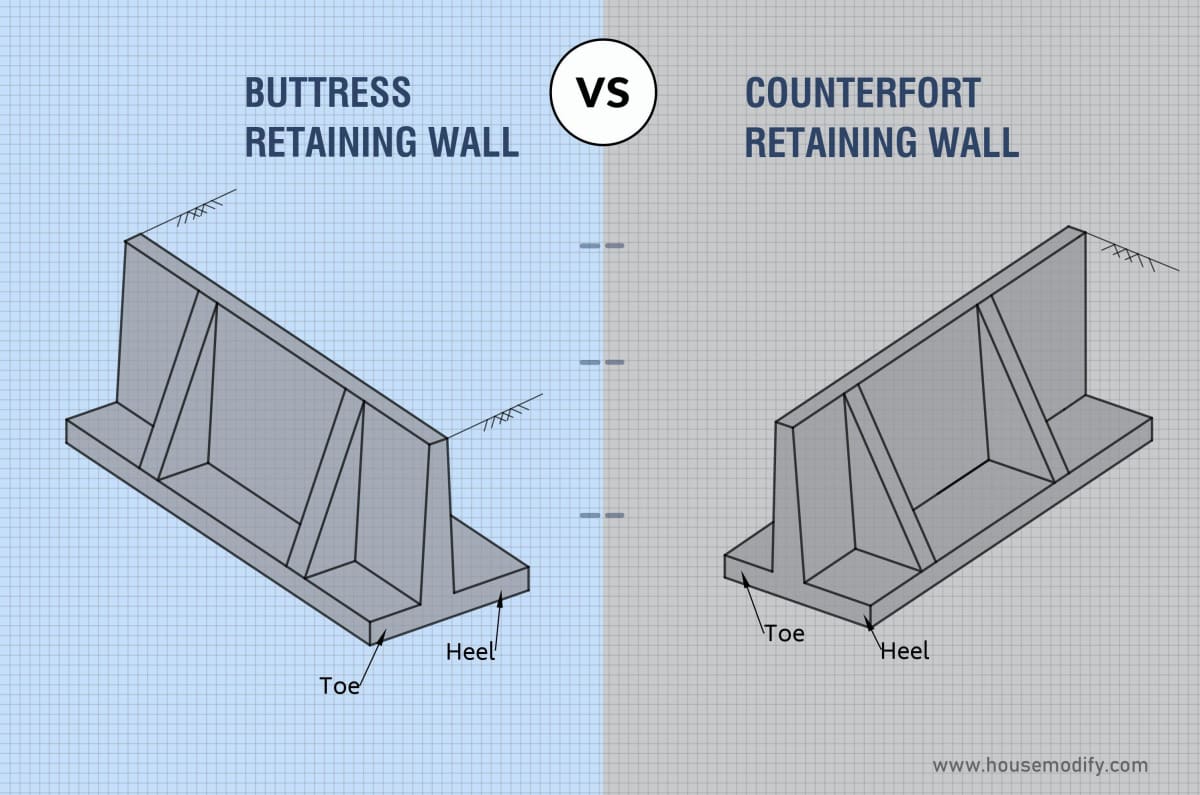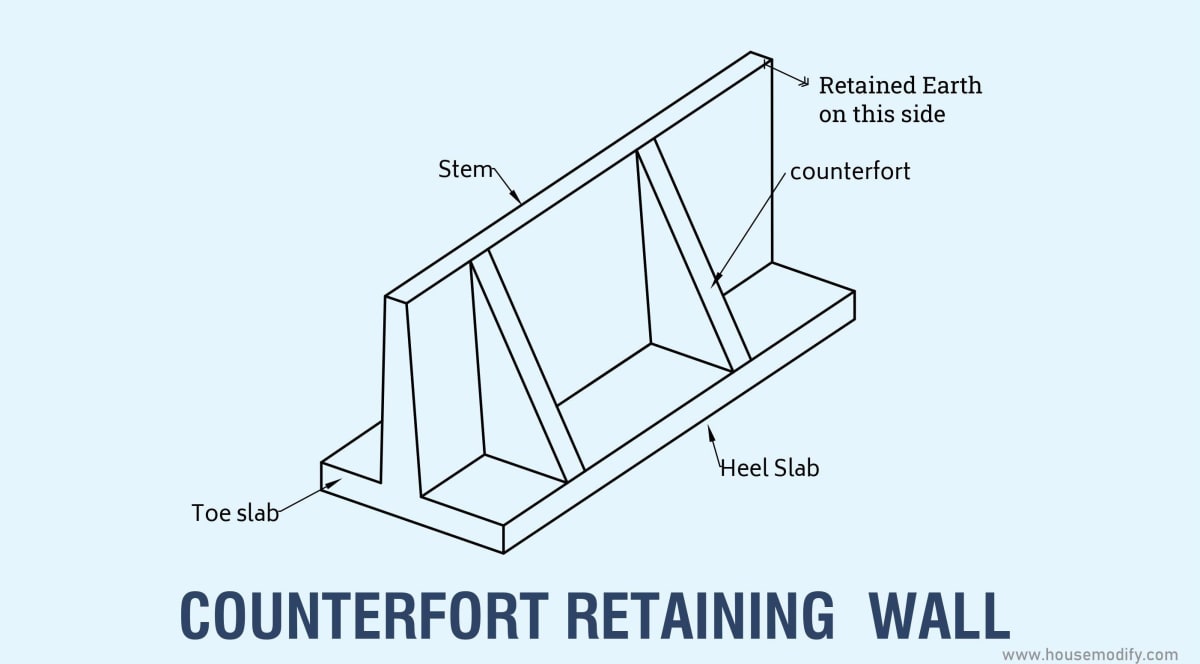Buttress and counterfort retaining wall are types of reinforced concrete retaining walls that hold soil and withstand lateral stresses.
Retaining walls play a huge role in supporting and holding the soil or other materials to preserve stability and prevent land erosion.
This article will focus on the significant difference between Buttress and counterfort retaining walls with their merits and demerits.
Buttress Retaining Wall Vs Counterfort Retaining Wall:

What is a Buttress Retaining Wall?
Buttress retaining wall is powerfully designed structures that prevent soil erosion and migration.
They consist of two primary components: buttresses and stem in some areas for greater rigidity and support.

Advantages of Buttress Retaining Wall:
1. Structural integrity:
A buttress retaining wall is more stable.
Walls of this nature have a high capacity to withstand tremendous pressure.
2. Aesthetic appeal:
These walls are beneficial in terms of the foundation of the building, as well as adding to the general character of the property.
3. Versatility in Design:
You can redesign this retaining wall to meet your unique needs.
It creates an individual look but, at the same time, does not disrupt the harmony with the adjacent area.
4. Erosion Control:
Buttress retaining walls primarily play the role of erosion control.
They stop the eroding of soils and keep your landscaping for a long time.
Disadvantages of Buttress Retaining Wall:
Here are the disadvantages of Buttress Retaining Walls:
1. High Cost:
The use of buttress retaining walls is expensive as it requires a lot of money and labor.
2. Space Requirement:
These giant walls require more space.
3. Maintenance:
These buttress retaining walls need their periodic serviceability, mainly where there occur soil movements or earthquakes.
4. Environmental Impact:
The environmental impacts of buttress retaining walls include disturbance of natural habitat zones and drainage system alterations.
Applications of Buttress Retaining Wall:
Here are the applications of Buttress Retaining Walls:
1. Slope Stabilization:
When it comes to stabilizing slopes, buttress retaining walls always come in handy.
2. Terraced Gardens:
The terrace is built by these walls many times over.
3. Highway and Infrastructure Projects:
Significant infrastructure development, like the construction of highways and widening of waysides, is made by buttress retaining walls.
4. Residential Landscaping:
The buttress retaining wall is the homeowner’s solution to landscape problems.
5. Recreational Areas:
Recreational spaces like sports fields, playgrounds, and parks have been constructed using buttress retaining walls.
6. Industrial Sites:
In the case of industrial sites (primarily hilly), controlling the landscape features is necessary.
What is Counterfort Retaining Wall?
All modern landscaping and civil engineering works with counterfort retaining walls.
Though these are primarily made for aesthetic purposes, they prevent soil erosion.
This exceptionality has made them famous among homeowners and different experts such as engineers, interior designers, etc.

Advantages of Counterfort Retaining Wall:
Here are the benefits of a counterfort retaining wall:
1. Excellent structural stability:
It is famous for its toughness.
2. Aesthetically pleasing:
Counterfort retaining walls can be modified to match your aesthetic specifications.
3. Space Optimization:
These retaining walls are economical in terms of available space.
4. Erosion Control:
Controlling soil erosion is essential in the landscape.
5. Low Maintenance:
A retaining wall will require minor maintenance.
As a result, the time and money spent on care is reduced, making it more affordable in the long run.
Disadvantages of Counterfort Retaining Wall:
Here are the disadvantages of counterfort retaining walls:
1. High Construction Cost:
Construction cost is the main drawback of counterfort retaining walls.
2. Space Requirement:
The counterfort and footing construction is incorporated into the counterfort retaining wall, which requires large clearances.
3. Aesthetic concerns:
Sometimes, these retaining walls can be more aesthetically pleasing.
4. Maintenance:
Counterfort retaining wall will require maintenance and repair.
5. Environmental Impact:
Some of the effects are the destruction of animal habitats and water runoff.
Applications of Counterfort Retaining Walls:
These types of counterfort retaining walls are used in a wide range of landscaping and construction applications.
Some common uses include:
1. Slope stabilization:
A counterfort retaining wall provides stabilization and reduces soil erosion.
2. Garden Terracing:
Gardening lovers can create a terrace in their garden using counterfort retaining walls.
3. Driveway and Pathway Support:
Counterfort retaining walls also support driveways and pathways many years later.
Also read: Difference between Breast Wall and Retaining Wall
What is the Difference Between Buttress and Counterfort Retaining Wall?
Now, let’s highlight the key difference between buttress and counterfort retaining wall as follows:
| Feature | Buttress Retaining Wall | Counterfort Retaining Wall |
|---|---|---|
| Location | Front side of the wall. | Backside of the wall. |
| Supporting Structure | Buttresses. | Counterforts. |
| Function | Compression members | Tension members. |
| Efficiency in Overturning Stability | Less efficient. | More efficient. |
| Height Suitability | Suitable for heights less than 9 m. | Suitable for heights 6 m and above. |
Also read: Difference between Shear Wall and Retaining Wall
Frequently Asked Questions (FAQs):
What is the difference between buttress and counterfort?
Buttresses are structurally more efficient and more economical than counterforts.
What is the maximum height of a counterfort retaining wall?
Counterfort retaining walls are economical for heights above about 6 m.
What code is used for retaining walls?
IS 456: 2000 is the code used for retaining walls.
Where is the counterfort retaining wall used?
Counterforts in retaining walls are used for walls above 8 to 12 meters in height.
Do retaining walls require regular maintenance?
Depending on the type of material of construction and environmental conditions, periodic inspection and maintenance are required at appropriate intervals to maintain the walls.
Can retaining walls be built in residential gardens for landscaping purposes?
Residential gardens can be more attractive and work well with a retaining wall.
Also read: Difference between Normal Wall and Retaining Wall
Conclusion:
However, buttresses and counterfort retaining wall are alternative solutions for soil support and stability.
They are also the cheapest and space-saving because the counterfort wall acts as a support for the tall fence.
While, the choice depends on the project requirements, budget, and available space.
Section Under: Retaining Walls








